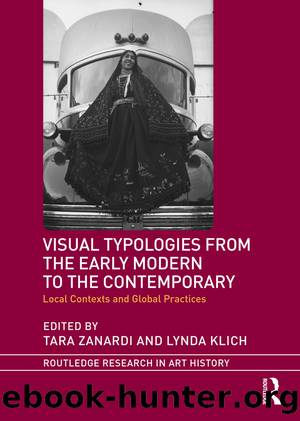Visual Typologies From the Early Modern to the Contemporary by Tara Zanardi Lynda Klich

Author:Tara Zanardi,Lynda Klich
Language: eng
Format: epub
Publisher: Taylor & Francis (CAM)
Fig. 9.4Christiano Junior, Cartes de visite, 1860.
Source: Museu Histórico Nacional, Rio de Janeiro.
The studio backdrop neutralizes the subjects by detaching them from any particular regional, cultural, or temporal setting. More importantly, it decontextualized the women and redefined them in entirely new socio-cultural terms as “finely-dressed women” in Candomblé dress.25 The neutrality of the background and accoutrements offset the woman’s exotic attire and physiognomy, creating an interesting balance between fact and fiction, imagination and reality, that proved popular among tourists and foreigners, contributing to the popularization, misconception, and objectification of Afro-Brazilian women as occult and exotic.
Ferrez, born in Rio de Janeiro to a French family of artists, and educated in France, established his photographic studio in 1865, after his apprenticeship in Franz Keller-Leuzinger’s studio, where he was first introduced to photography. In 1875, Ferrez served as the photographer of the Brazilian Geological Commission, through which he mastered the art of panoramic photography. While Ferrez, according to his grandson Gilberto Ferrez, “‘was never interested in portraits,’” but rather in landscape photography, it was with portraiture, as noted by historians Pedro Vasquez and Robert Myers, that “one made money then.”26 Ferrez’s ties with the photography enthusiast Dom Pedro II, helped finance his photographic career of panoramic views and portraits of slaves, baianas, Amerindians, street vendors, and plantation workers.
One among many creating portraits of baianas, Ferrez photographed the women in studios with domestic props like tables, chairs, and umbrellas that positioned them as higher class, but also as culturally displaced [see Fig. 9.5]. In terms of pose and dress, Ferrez carefully placed the hands of the model in an elegant pose and her body is shown in profile view. As described by Erika Billeter, Ferrez used “models dressed in picturesque costume, to sell to tourists,”27 recalling the language of European-style portraits like Woman from Bahia (Fig. 9.3). Her statement on audience seems justified, since locals, most likely accustomed to the mixed population, were not interested in these subjects. Whether they were models or actual Candomblé participants is unknown. Nonetheless, the consistency of their dress and the specificity of the garments worn by Candomblé priestesses/practitioners—the camizu, saia, ojá, and ileki—demonstrate that Ferrez purposely sought to create and commercialize Afro-Brazilian Candomblé types.
Download
This site does not store any files on its server. We only index and link to content provided by other sites. Please contact the content providers to delete copyright contents if any and email us, we'll remove relevant links or contents immediately.
The Art of Boudoir Photography: How to Create Stunning Photographs of Women by Christa Meola(18581)
Red Sparrow by Jason Matthews(5425)
Harry Potter 02 & The Chamber Of Secrets (Illustrated) by J.K. Rowling(3646)
In a Sunburned Country by Bill Bryson(3508)
Drawing Cutting Edge Anatomy by Christopher Hart(3485)
Figure Drawing for Artists by Steve Huston(3409)
Harry Potter and the Prisoner of Azkaban (Book 3) by J. K. Rowling(3324)
The Daily Stoic by Holiday Ryan & Hanselman Stephen(3264)
Japanese Design by Patricia J. Graham(3138)
The Roots of Romanticism (Second Edition) by Berlin Isaiah Hardy Henry Gray John(2888)
Make Comics Like the Pros by Greg Pak(2883)
Stacked Decks by The Rotenberg Collection(2843)
Draw-A-Saurus by James Silvani(2687)
Harry Potter and the Deathly Hallows (7) by J.K. Rowling(2681)
Tattoo Art by Doralba Picerno(2623)
On Photography by Susan Sontag(2607)
Churchill by Paul Johnson(2544)
The Daily Stoic by Ryan Holiday & Stephen Hanselman(2527)
Drawing and Painting Birds by Tim Wootton(2475)
